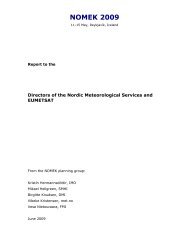International Symposium on Mitigative Measures against Snow ...
International Symposium on Mitigative Measures against Snow ...
International Symposium on Mitigative Measures against Snow ...
You also want an ePaper? Increase the reach of your titles
YUMPU automatically turns print PDFs into web optimized ePapers that Google loves.
<str<strong>on</strong>g>Internati<strong>on</strong>al</str<strong>on</strong>g> <str<strong>on</strong>g>Symposium</str<strong>on</strong>g> <strong>on</strong> <strong>Mitigative</strong> <strong>Measures</strong> <strong>against</strong> <strong>Snow</strong> Avalanches<br />
Egilsstaðir, Iceland, March 11–14, 2008<br />
Neskaupsstaður in 1974 were 12 died. But in the time between the resp<strong>on</strong>se to these disasters<br />
in 1974 and 1983, the voluntary rescue organizati<strong>on</strong>s in Iceland hand g<strong>on</strong>e through substantial<br />
changes. In 1983, there were three organizati<strong>on</strong>s of voluntary rescuers in Iceland and the<br />
cooperati<strong>on</strong> between them in Search and Rescue was <strong>on</strong> an “ad hoc” basis during operati<strong>on</strong>s.<br />
The <strong>on</strong>ly truly joint factor was <strong>on</strong>e VHF communicati<strong>on</strong>s system they operated together.<br />
During operati<strong>on</strong>s, such as when avalanches struck build up areas, the rescue teams of the<br />
three organizati<strong>on</strong>s were under command and c<strong>on</strong>trol of the local police chief, and <strong>on</strong> a<br />
nati<strong>on</strong>al basis the coordinati<strong>on</strong> was d<strong>on</strong>e through the Nati<strong>on</strong>al Civil Defence command center<br />
in Reykavík. At the center, all three organizati<strong>on</strong>s were represented by a member of the<br />
respective organizati<strong>on</strong>s as the crew of the command center during operati<strong>on</strong>s. In 1985, the<br />
organizati<strong>on</strong>s build up in cooperati<strong>on</strong> with the Ministry of Justice their own command<br />
structure. That was d<strong>on</strong>e by setting up a joint Nati<strong>on</strong>al SAR Command of the rescue teams<br />
and under that system of 18 area commands to work for the authorities resp<strong>on</strong>sible (Police,<br />
aviati<strong>on</strong> authorities and those resp<strong>on</strong>sible for Search and Rescue at sea). And in 1991, the<br />
three organizati<strong>on</strong>s became two when two of them, the Associati<strong>on</strong> of Air-Ground Rescue<br />
teams and the Associati<strong>on</strong> of scout rescue teams merged together in Landsbjörg-Associati<strong>on</strong><br />
of Icelandic Rescue teams. The other organizati<strong>on</strong> was the Slysavarnafélag Íslands-Nati<strong>on</strong>al<br />
Life-saving associati<strong>on</strong> of Iceland-NLAI. (Today there is <strong>on</strong>ly <strong>on</strong>e organizati<strong>on</strong> − ICESAR<br />
Icelandic Associati<strong>on</strong> for Search and Rescue.) In 1994, Nati<strong>on</strong>al SAR Command was<br />
representing the rescue teams in the Nati<strong>on</strong>al Civil Defence Command Center.<br />
TRAINING IN AVALANCHE/URBAN SAR BEFORE THE DISASTERS<br />
Training of the teams at the time came from various sources. But in 1994, Landsbjörg and<br />
NLAI started to operate a joint Rescue school − The Icelandic Rescue School. (It was a<br />
follow-up <strong>on</strong> the work of a school with the same name operated by Landsbjörg and its former<br />
associati<strong>on</strong>s since 1977.) The school was already working <strong>on</strong> standardizing training both in<br />
avalanche and Urban SAR at the time. But since 1989, a part of the Urban Search and Rescue<br />
(USAR) training of the NLAI was based <strong>on</strong> experience of rescuers from the 1974 avalanches<br />
in Neskaupsstaður. Several rescuers in the area of Súðavík and Flateyri, for example Jón<br />
Svanberg Hjartars<strong>on</strong>, who was the incident commander in Flateyri for the first hours after the<br />
disaster struck, has c<strong>on</strong>firmed that the USAR training he attended with NLAI made it possible<br />
for him to organise the work during the initial hours (Arnalds, 1996).<br />
SÚÐAVÍK AVALANCHE<br />
The first avalanche struck the town in the early hours of the morning of 16 th of January 1995.<br />
The weather c<strong>on</strong>diti<strong>on</strong>s were horrible and it was impossible for the rescue teams from the<br />
nearest towns to resp<strong>on</strong>d to the area by road. In<br />
the end, they had to sail by ships. So for the first<br />
hours, the local populati<strong>on</strong>, including the local<br />
rescue teams tried to do what was possible. Twenty<br />
people were missing and the local mayor asked<br />
all the populati<strong>on</strong> to go to the local freezing plant<br />
by the sea, both to get status <strong>on</strong> who was missing<br />
and also to start SAR work in the area. The rescue<br />
team’s Nati<strong>on</strong>al SAR Command was not informed<br />
of the disaster until 90 minutes after the avalanche<br />
fell. At 09:40 the Nati<strong>on</strong>al SAR Command<br />
102 Icelandic voluntary rescue teams in the Súðavík and Flateyri avalanches in 1995











